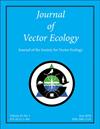Potential geographic distribution of Ixodes cookei, the vector of Powassan virus
IF 1.3
3区 农林科学
Q2 ENTOMOLOGY
引用次数: 2
Abstract
ABSTRACT: Ixodes cookei Packard, the groundhog tick or woodchuck tick, is the main known vector of Powassan virus (POWV) disease in North America and an ectoparasite that infests diverse small- and mid-size mammals for blood meals to complete its life stages. Since I. cookei spends much of its life cycle off the host and needs hosts for a blood meal in order to pass to the next life stage, it is susceptible to changes in environmental conditions. We used a maximum-entropy approach to ecological niche modeling that incorporates detailed model-selection routes to link occurrence data to climatic variables to assess the potential geographic distribution of I. cookei under current and likely future climate conditions. Our models identified suitable areas in the eastern United States, from Tennessee and North Carolina north to southern Canada, including Nova Scotia, New Brunswick, eastern Newfoundland and Labrador, southern Quebec, and Ontario; suitable areas were also in western states, including Washington and Oregon and restricted areas of northern Idaho, northwestern Montana, and adjacent British Columbia, in Canada. This study produces the first maps of the potential geographic distribution of I. cookei. Documented POWV cases overlapped with suitable areas in the northeastern states; however, the presence of this disease in areas classified by our models as not suitable by our models but with POWV cases (Minnesota and North Dakota) requires more study.波瓦桑病毒传播媒介库克伊蚊的潜在地理分布
摘要:库克硬蜱(Ixodes cookei Packard),土拨鼠蜱或木拨鼠蜱,是北美已知的波瓦桑病毒(POWV)病的主要媒介,是一种寄生在各种中小型哺乳动物身上的外寄生虫,为完成其生命阶段的血餐。由于野鸡的大部分生命周期都在远离宿主的环境中度过,并且需要宿主吃一顿血才能进入下一个生命阶段,因此它很容易受到环境条件变化的影响。我们在生态位建模中使用了最大熵方法,该方法结合了详细的模型选择路线,将发生数据与气候变量联系起来,以评估在当前和未来可能的气候条件下库克虫的潜在地理分布。我们的模型确定了美国东部的合适地区,从田纳西州和北卡罗来纳州到加拿大南部,包括新斯科舍省、新不伦瑞克省、纽芬兰和拉布拉多省东部、魁北克省南部和安大略省;合适的地区也在西部各州,包括华盛顿州和俄勒冈州,以及爱达荷州北部、蒙大拿州西北部和邻近的加拿大不列颠哥伦比亚省的限制区。这项研究首次绘制了库克伊蚊的潜在地理分布图。记录在案的POWV病例与东北部各州的适当地区重叠;然而,这种疾病在我们的模型分类为不适合我们的模型但有POWV病例的地区(明尼苏达州和北达科他州)的存在需要更多的研究。
本文章由计算机程序翻译,如有差异,请以英文原文为准。
求助全文
约1分钟内获得全文
求助全文
来源期刊

Journal of Vector Ecology
生物-昆虫学
CiteScore
2.60
自引率
5.90%
发文量
31
审稿时长
6-12 weeks
期刊介绍:
The Journal of Vector Ecology is an international journal published by the Society for Vector Ecology. It is concerned with all aspects of the biology, ecology, and control of arthropod and vertebrate vectors and the interrelationships between the vectors and the agents of disease that they transmit. The journal publishes original research articles and scientific notes, as well as comprehensive reviews of vector biology based on presentations at Society meetings. All papers are reviewed by at least two qualified scientists who recommend their suitability for publication. Acceptance of manuscripts is based on their scientific merit and is the final decision of the editor, but these decisions may be appealed to the editorial board. The journal began publishing in 1974 and now publishes on-line only.
 求助内容:
求助内容: 应助结果提醒方式:
应助结果提醒方式:


